child lock TOYOTA TACOMA 2013 Owners Manual (in English)
[x] Cancel search | Manufacturer: TOYOTA, Model Year: 2013, Model line: TACOMA, Model: TOYOTA TACOMA 2013Pages: 524, PDF Size: 10.96 MB
Page 2 of 524

TABLE OF CONTENTSIndex
2
1-1. Key informationKeys ..................................... 32
1-2. Opening, closing and locking the doors
Wireless remote control ....... 34
Side doors ............................ 37
Access doors (Access Cab models only) ....................... 41
Tailgate ................................ 42
1-3. Adjustable components (seats, mirrors, steering
wheel)
Front seats ........................... 47
Rear seats (Access Cab and Double Cab models) .......... 52
Head restraints ..................... 56
Seat belts ............................. 61
Steering wheel ..................... 67
Anti-glare inside rear view mirror .................................. 68
Outside rear view mirrors ..... 73
1-4. Opening and closing the windows
Power windows .................... 76
Back window (vehicles with sliding type) ........................ 78
1-5. Refueling Opening the fuel tank cap .... 79 1-6. Theft deterrent system
Engine immobilizer system ... 82
1-7. Safety information Correct driving posture ......... 85
SRS airbags ......................... 87
Front passenger occupant classification system ......... 101
Child restraint systems ....... 106
Installing child restraints ..... 110
2-1. Driving procedures Driving the vehicle .............. 130
Engine (ignition) switch....... 141
Automatic transmission ...... 144
Manual transmission........... 148
Turn signal lever ................. 151
Parking brake ..................... 152
Horn .................................... 154
2-2. Gauges and meters Gauges and meters ............ 155
Indicators and warning lights ................................. 158
2-3. Operating the lights and wipers
Headlight switch ................. 162
Fog light switch ................... 165
Windshield wipers and washer .............................. 166
1Before driving
2When driving
Page 31 of 524

Before driving1
31
1-1. Key informationKeys ................................... 32
1-2. Opening, closing and locking the doors
Wireless remote control ..... 34
Side doors .......................... 37
Access doors (Access Cab models only) .................... 41
Tailgate .............................. 42
1-3. Adjustable components (seats, mirrors, steering
wheel)
Front seats ......................... 47
Rear seats (Access Cab and Double Cab
models) ............................ 52
Head restraints................... 56
Seat belts ........................... 61
Steering wheel ................... 67
Anti-glare inside rear view mirror ....................... 68
Outside rear view mirrors ... 73 1-4. Opening and closing
the windows
Power windows .................. 76
Back window (vehicles with sliding type) .............. 78
1-5. Refueling Opening the fuel tank cap ................................... 79
1-6. Theft deterrent system Engine immobilizer system ............................. 82
1-7. Safety information Correct driving posture....... 85
SRS airbags ....................... 87
Front passenger occupant classification system ...... 101
Child restraint systems..... 106
Installing child restraints... 110
Page 39 of 524
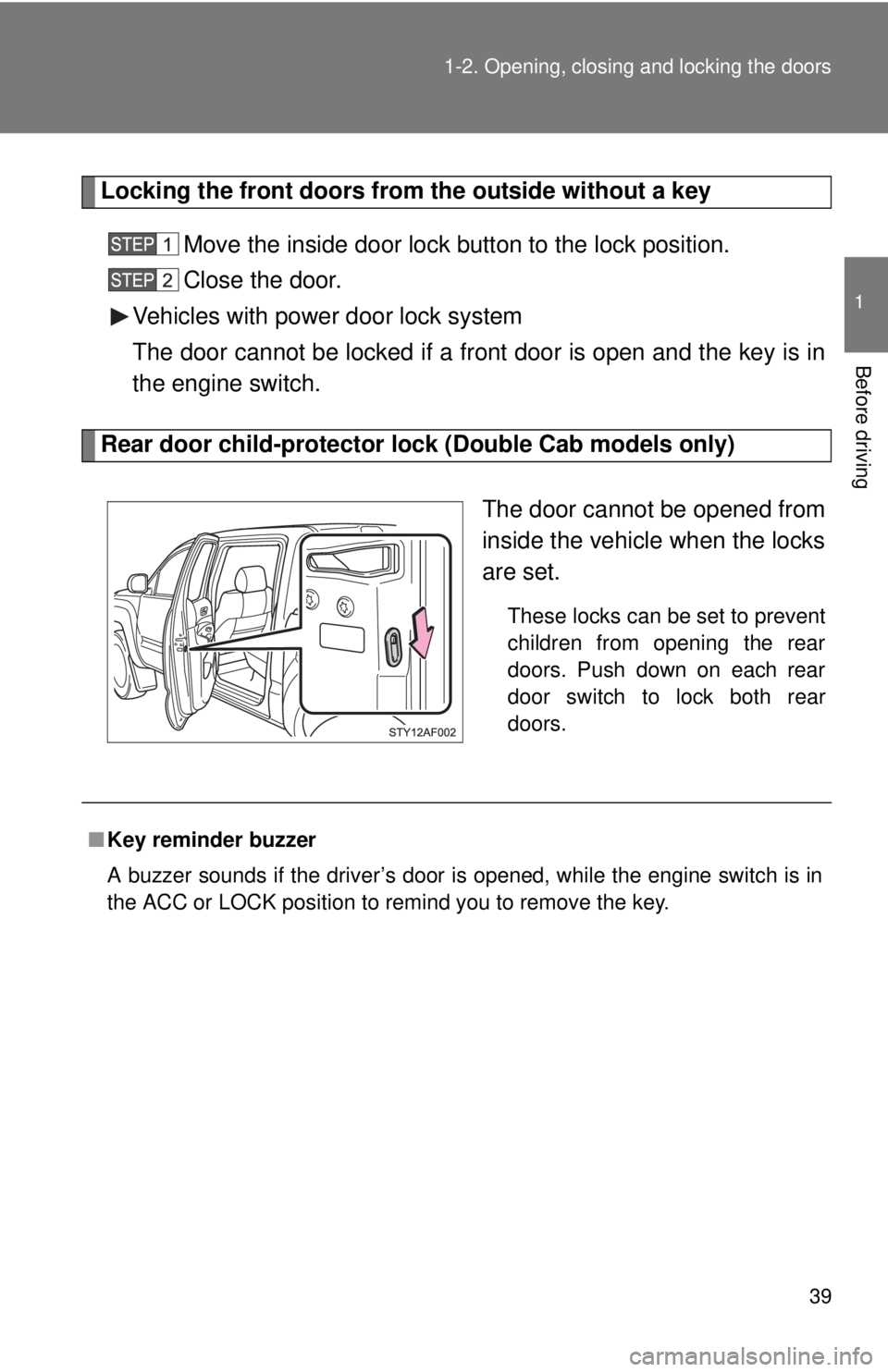
39
1-2. Opening, closing and locking the doors
1
Before driving
Locking the front doors from the outside without a key
Move the inside door lock button to the lock position.
Close the door.
Vehicles with power door lock system
The door cannot be locked if a front door is open and the key is in
the engine switch.
Rear door child-protector lock (Double Cab models only)
The door cannot be opened from
inside the vehicle when the locks
are set.
These locks can be set to prevent
children from opening the rear
doors. Push down on each rear
door switch to lock both rear
doors.
■Key reminder buzzer
A buzzer sounds if the driver’s door is opened, while the engine switch is in
the ACC or LOCK position to remind you to remove the key.
Page 40 of 524
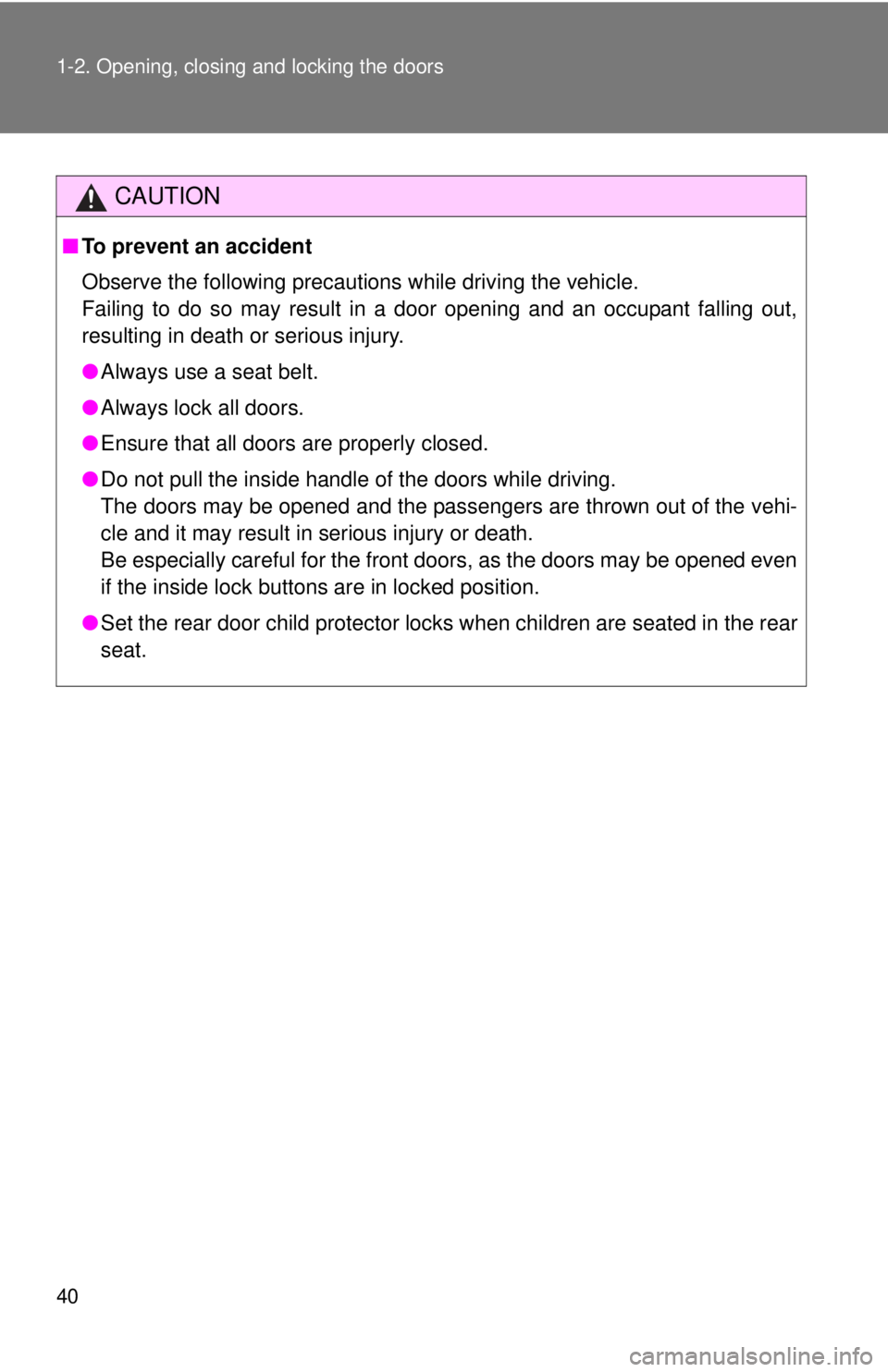
40 1-2. Opening, closing and locking the doors
CAUTION
■To prevent an accident
Observe the following precautions while driving the vehicle.
Failing to do so may result in a door opening and an occupant falling out,
resulting in death or serious injury.
●Always use a seat belt.
● Always lock all doors.
● Ensure that all doors are properly closed.
● Do not pull the inside handle of the doors while driving.
The doors may be opened and the passengers are thrown out of the vehi-
cle and it may result in serious injury or death.
Be especially careful for the front doors, as the doors may be opened even
if the inside lock buttons are in locked position.
● Set the rear door child protector locks when children are seated in the rear
seat.
Page 63 of 524

63
1-3. Adjustable components (s
eats, mirrors, steering wheel)
1
Before driving
■Emergency locking retractor (ELR)
The retractor will lock the belt during a sudden stop or on impact. It may also
lock if you lean forward too quickly. A slow, easy motion will allow the belt to
extend so that you can move around fully.
■ Automatic locking retractor (ALR)
When a passenger’s shoulder belt is completely extended and then
retracted even slightly, the belt is locked in that position and cannot be
extended. This feature is used to hold the child restraint system (CRS) firmly.
To free the belt again, fully retract the belt and then pull the belt out once
more. ( P. 110)
■ Pregnant women
■ People suffering illness
Obtain medical advice and wear the seat belt in the proper way.
■ Child seat belt usage
The seat belts of your vehicle were principally designed for persons of adult
size.
●Use a child restraint system appropriate for the child, until the child
become large enough to properly wear the vehicle’s seat belt. ( P. 106)
● When the child becomes large enough to properly wear the vehicle’s
seat belt, follow the instructions on P. 61 regarding seat belt usage.
Obtain medical advice and wear the seat
belt in the proper way. ( P. 61)
Women who are pregnant should position
the lap belt as low as possible over the
hips in the same manner as other occu-
pants. Extend the shoulder belt com-
pletely over the shoulder and position the
belt across the chest. Avoid belt contact
over the rounding of the abdominal area.
If the seat belt is not worn properly, not
only a pregnant woman, but also the fetus
could suffer death or serious injury as a
result of sudden braking or a collision.
Page 65 of 524
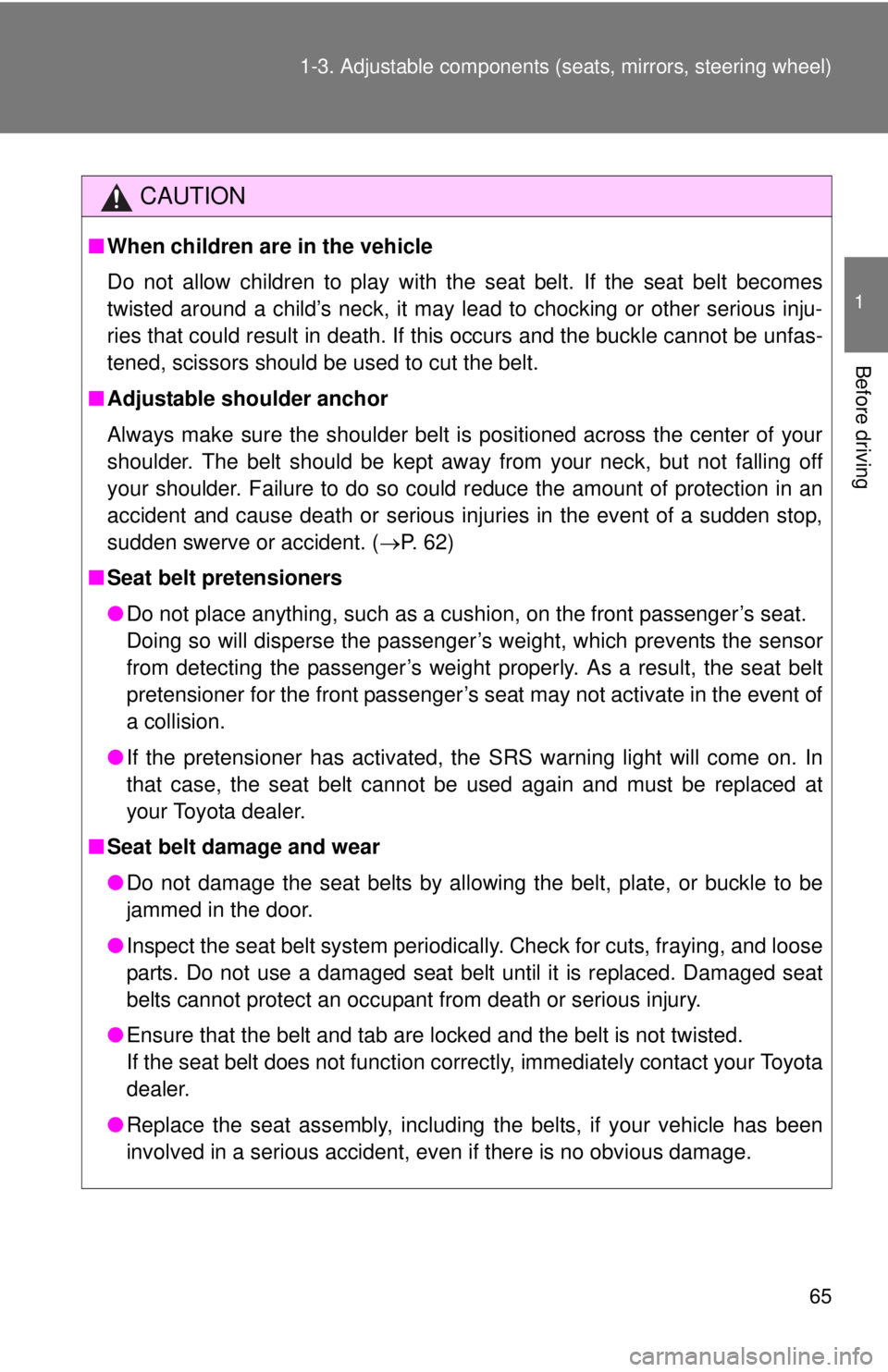
65
1-3. Adjustable components (s
eats, mirrors, steering wheel)
1
Before driving
CAUTION
■When children are in the vehicle
Do not allow children to play with the seat belt. If the seat belt becomes
twisted around a child’s neck, it may lead to chocking or other serious inju-
ries that could result in death. If this occurs and the buckle cannot be unfas-
tened, scissors should be used to cut the belt.
■ Adjustable shoulder anchor
Always make sure the shoulder belt is positioned across the center of your
shoulder. The belt should be kept away from your neck, but not falling off
your shoulder. Failure to do so could reduce the amount of protection in an
accident and cause death or serious injuries in the event of a sudden stop,
sudden swerve or accident. ( P. 62)
■ Seat belt pretensioners
●Do not place anything, such as a cushion, on the front passenger’s seat.
Doing so will disperse the passenger’s weight, which prevents the sensor
from detecting the passenger’s weight properly. As a result, the seat belt
pretensioner for the front passenger’s seat may not activate in the event of
a collision.
● If the pretensioner has activated, the SRS warning light will come on. In
that case, the seat belt cannot be used again and must be replaced at
your Toyota dealer.
■ Seat belt damage and wear
●Do not damage the seat belts by allowing the belt, plate, or buckle to be
jammed in the door.
● Inspect the seat belt system periodically. Check for cuts, fraying, and loose
parts. Do not use a damaged seat belt until it is replaced. Damaged seat
belts cannot protect an occupant from death or serious injury.
● Ensure that the belt and tab are locked and the belt is not twisted.
If the seat belt does not function correctly, immediately contact your Toyota
dealer.
● Replace the seat assembly, including the belts, if your vehicle has been
involved in a serious accident, even if there is no obvious damage.
Page 77 of 524
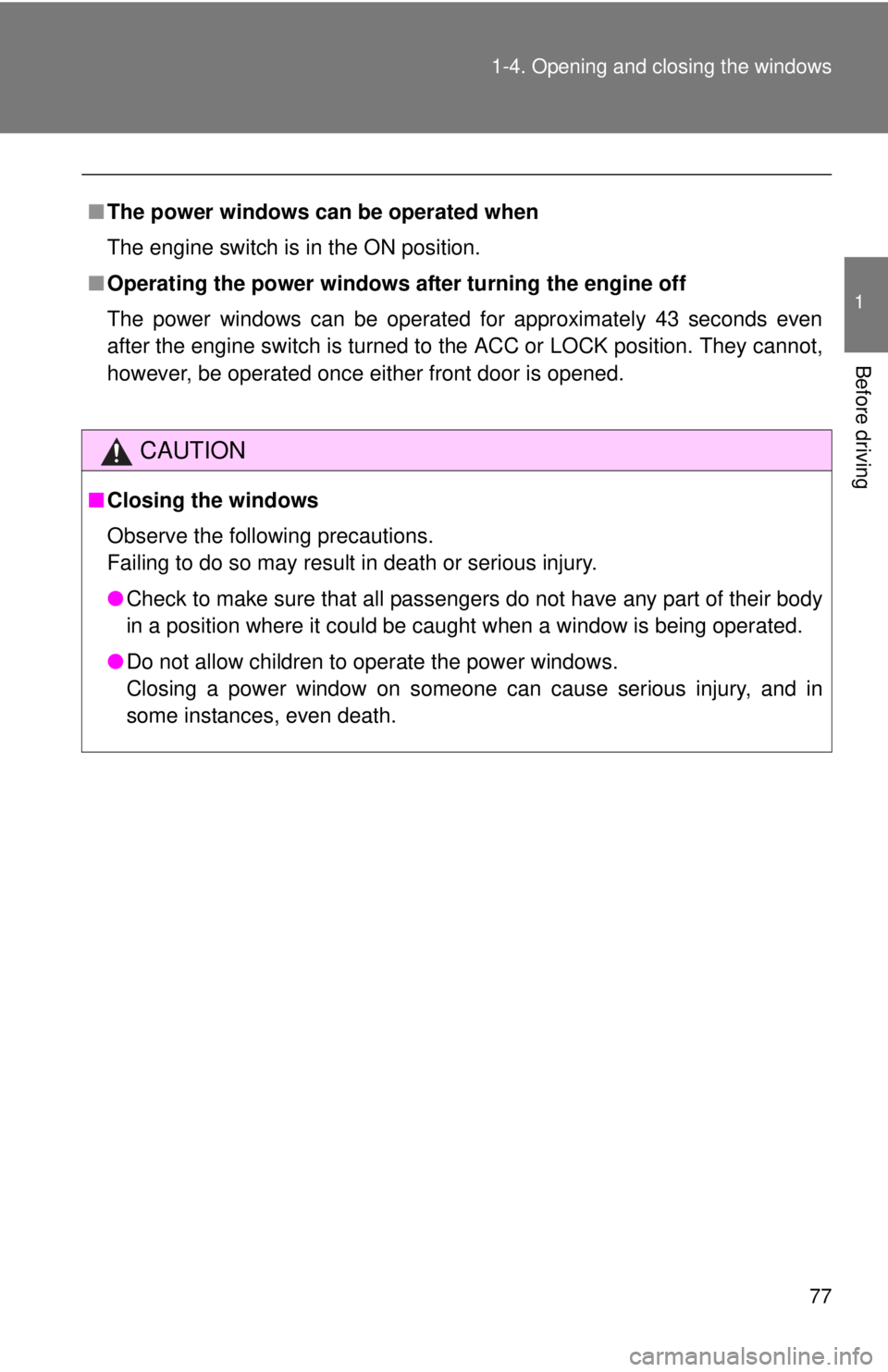
77
1-4. Opening and closing the windows
1
Before driving
■
The power windows can be operated when
The engine switch is in the ON position.
■ Operating the power windows after turning the engine off
The power windows can be operated for approximately 43 seconds even
after the engine switch is turned to the ACC or LOCK position. They cannot,
however, be operated once either front door is opened.
CAUTION
■Closing the windows
Observe the following precautions.
Failing to do so may result in death or serious injury.
●Check to make sure that all passengers do not have any part of their body
in a position where it could be caught when a window is being operated.
● Do not allow children to operate the power windows.
Closing a power window on someone can cause serious injury, and in
some instances, even death.
Page 111 of 524
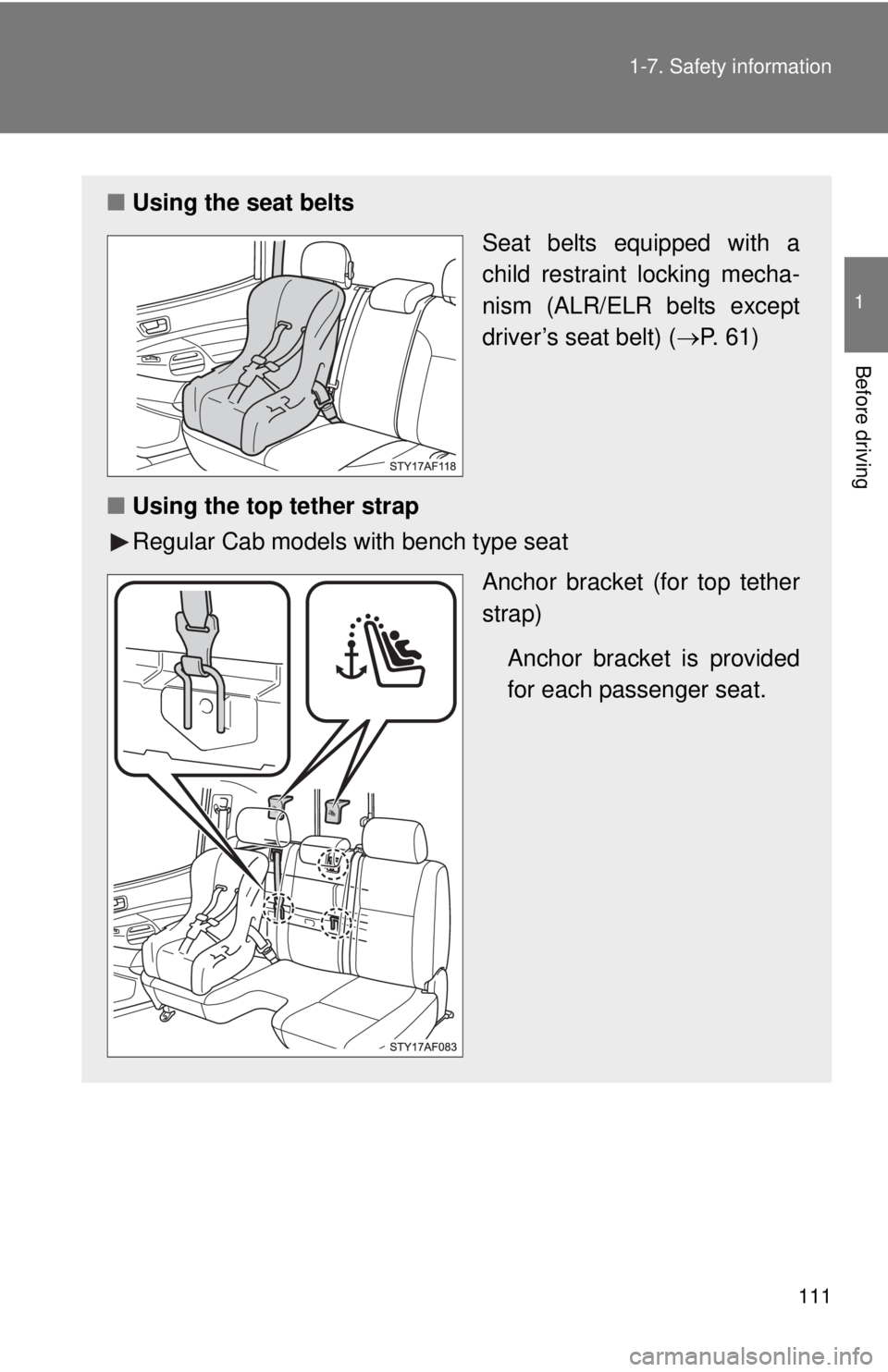
111
1-7. Safety information
1
Before driving
■
Using the seat belts
Seat belts equipped with a
child restraint locking mecha-
nism (ALR/ELR belts except
driver’s seat belt) (P. 61)
■ Using the top tether strap
Regular Cab models with bench type seat
Anchor bracket (for top tether
strap)
Anchor bracket is provided
for each passenger seat.
Page 117 of 524
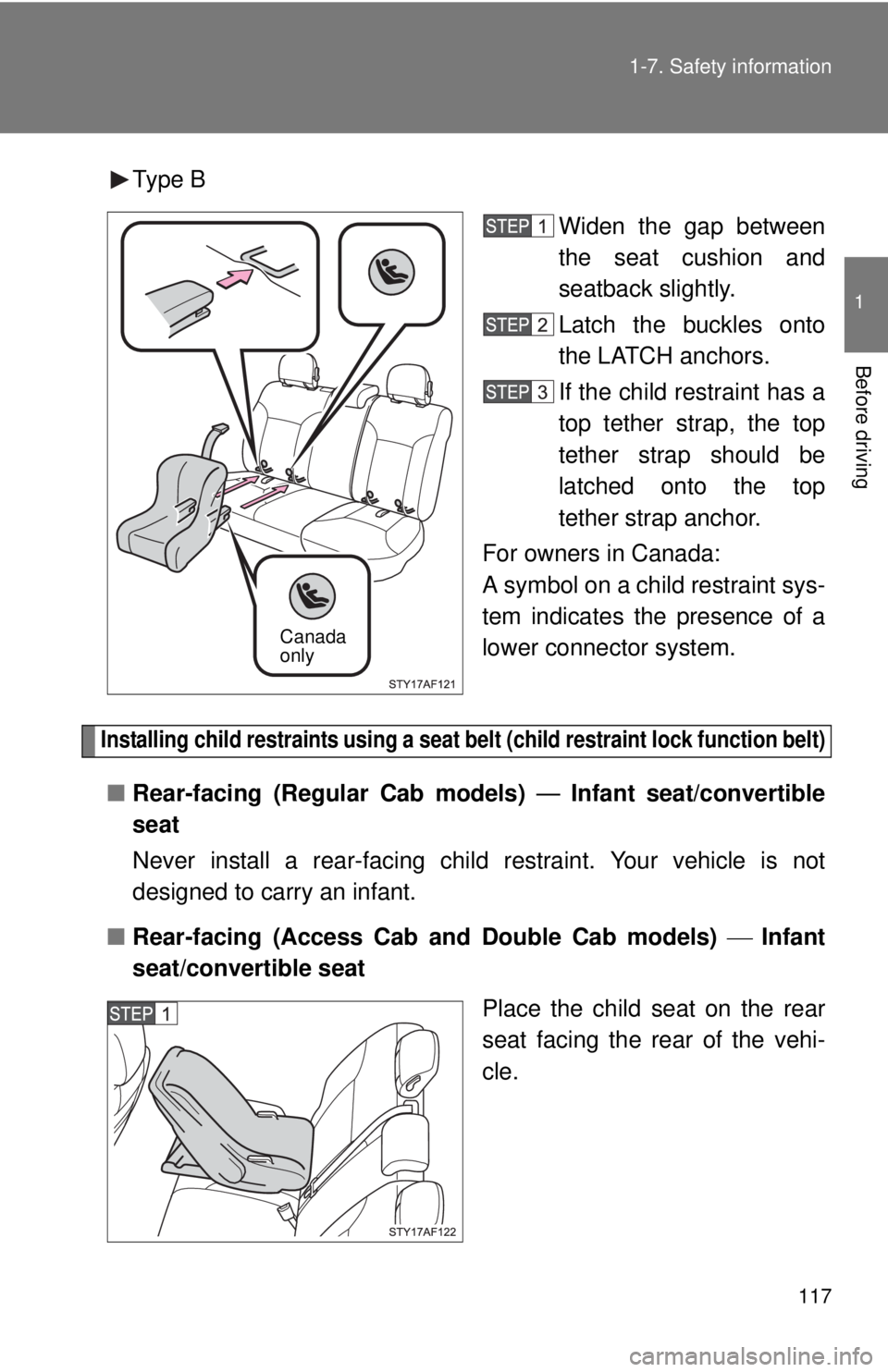
117
1-7. Safety information
1
Before driving
Type B
Widen the gap between
the seat cushion and
seatback slightly.
Latch the buckles onto
the LATCH anchors.
If the child restraint has a
top tether strap, the top
tether strap should be
latched onto the top
tether strap anchor.
For owners in Canada:
A symbol on a child restraint sys-
tem indicates the presence of a
lower connector system.
Installing child restraints using a seat belt (child restraint lock function belt)
■ Rear-facing (Regular Cab models) — Infant seat/convertible
seat
Never install a rear-facing child restraint. Your vehicle is not
designed to carry an infant.
■ Rear-facing (Access Cab and Double Cab models) Infant
seat/convertible seat
Place the child seat on the rear
seat facing the rear of the vehi-
cle.
Canada
only
Page 118 of 524
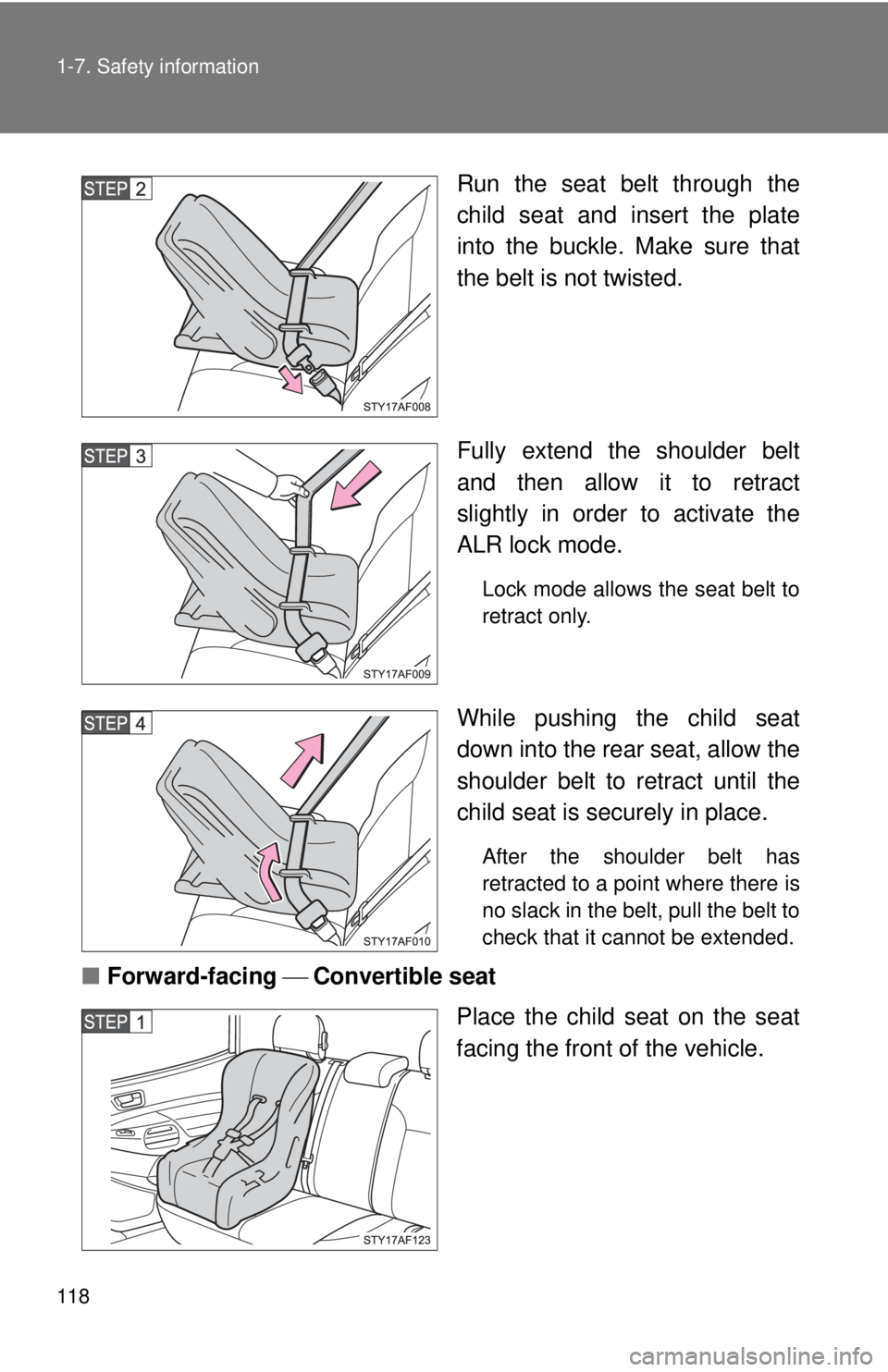
118 1-7. Safety information
Run the seat belt through the
child seat and insert the plate
into the buckle. Make sure that
the belt is not twisted.
Fully extend the shoulder belt
and then allow it to retract
slightly in order to activate the
ALR lock mode.
Lock mode allows the seat belt to
retract only.
While pushing the child seat
down into the rear seat, allow the
shoulder belt to retract until the
child seat is securely in place.
After the shoulder belt has
retracted to a point where there is
no slack in the belt, pull the belt to
check that it cannot be extended.
■Forward-facing Convertible seat
Place the child seat on the seat
facing the front of the vehicle.